
British postcard by Ross Verlag, no. 3531/2, 1928-1929. Photo: MGM. Greta Garbo in Love (Edmund Goulding, 1927).

Russian postcard by Goziak, Moscow, series, no. 2, no. 98826, 1927. Photo: Russell Ball. The card was issued in an edition of 20,000 copies.
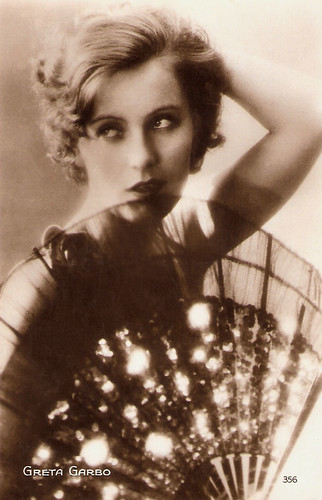
French postcard by Cinémagazine-Edition (CE), Paris, no. 356.
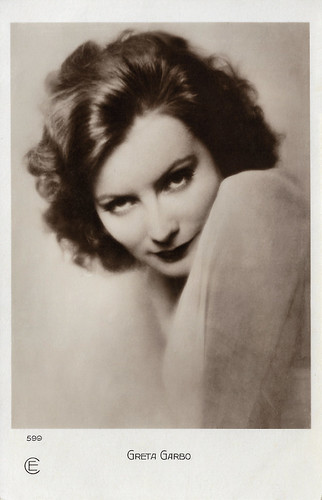
French postcard by Cinémagazine-Edition (CE), Paris, no. 599.
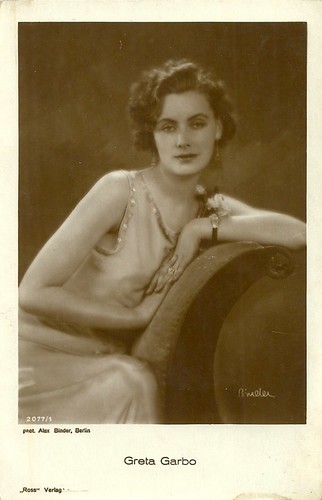
German postcard by Ross Verlag, no. 2077/1, 1927-1928. Photo: Alex Binder, Berlin.
Before going to Hollywood, Garbo starred in the German film Die freudlose Gasse/The Joyless Street (1925) by Georg Wilhelm Pabst. Berlin-based photographer Alex Binder of Atelier Binder made the picture above during the shooting of Die freudlose Gasse in 1924.

German postcard by Ross Verlag, no. 2010/2, 1927-1928. Photo: Parufamet. Publicity still for Torrent (Monta Bell, 1926).
Following Die freudlose Gasse/The Joyless Street (G.W. Pabst, 1925) both Greta Garbo and her friend and mentor Mauritz Stiller were offered contracts with MGM. Her first film for the studio was the silent production Torrent (Monta Bell, 1926).
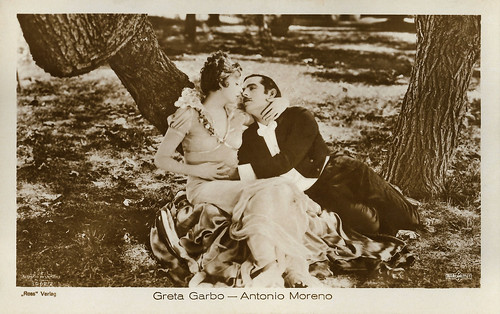
German postcard by Ross Verlag, no. 3062/2, 1928-1929. Photo: Metro-Goldwyn-Mayer / Parufamet. Greta Garbo and Antonio Moreno in The Temptress (Fred Niblo, Mauritz Stiller, 1926).
Department Store Clerk
Greta Garbo was born as Greta Lovisa Gustafsson in Stockholm in 1905. Her parents were Anna Lovisa (Johansdotter), who worked at a jam factory, and Karl Alfred Gustafsson, a labourer. She had an older sister and brother, Alva and Sven. They grew up in a rundown Stockholm district.
Few who knew Greta in her formative years would have predicted her illustrious career. In school, she did little to distinguish herself; nor was her first job, as a barbershop lather girl, indicative of future greatness.
Her father died when she was 14, leaving the family destitute. Greta was forced to leave school and work as a clerk in the PUB department store, where she also would model for newspaper ads.
She photographed beautifully. Her first film aspirations came when she appeared in two short film advertisements, Herr och fru Stockholm/Mr. and Mrs. Stockholm (Ragnar Ring, 1920) and Konsum Stockholm Promo/How Not to Dress (Ragnar Ring, 1921), both were financed by PUB.
Greta also appeared in a one-reel film for a local bakery. The films were seen by director Erik Arthur Petschler who gave her a small part as a bathing beauty in his comedy Luffar-Petter/Peter the Tramp (Erik A. Petschler, 1922).

French postcard by Cinémagazine-Edition, no. 94. Photo: Gaumont-Metro. Lars Hanson and Greta Garbo in Flesh and the Devil (Clarence Brown, 1926).
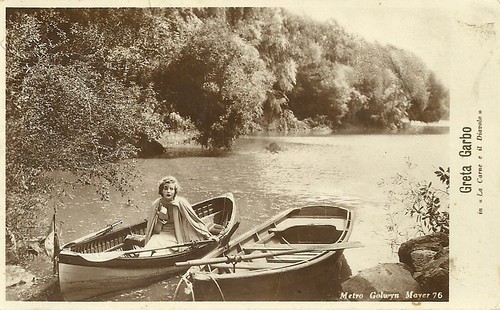
Italian postcard, no. 76. Photo: Metro-Goldwyn-Mayer. Greta Garbo in Flesh and the Devil (Clarence Brown, 1926).
Reportedly, the first scene in Flesh and the Devil between John Gilbert and Greta Garbo in the train station was also the first time Gilbert ever saw Garbo. He falls in love on camera, so completely in love that he never went back home to his wife.

German postcard by Ross Verlag, no. 3532/3, 1928-1929. Photo: Metro-Goldwyn-Mayer. John Gilbert and Greta Garbo in Love (Edmund Goulding, 1927), based on Lev Tolstoy's 'Anna Karenina'.

German postcard by Ross Verlag, no. 5106/1, 1930-1931. Photo: Metro-Goldwyn-Mayer. Greta Garbo in Love (Edmund Goulding, 1927).

German postcard by Ross Verlag, Foreign, no. 3787/4, 1928-1929. Photo: Metro-Goldwyn-Mayer. Publicity still for The Mysterious Lady (Fred Niblo, 1928) with Conrad Nagel. Collection: Joanna.
We love the taglines for this film: "No man knew what she really was. And no man could resist her exotic beauty. A famous Russian spy, moving through the lives of men, in a maze of intrigue, passion and love."

German postcard by Ross Verlag, no. 4132/2, 1929-1930. Photo: Metro Goldwyn Mayer. Greta Garbo in The Mysterious Lady (Fred Niblo, 1928).
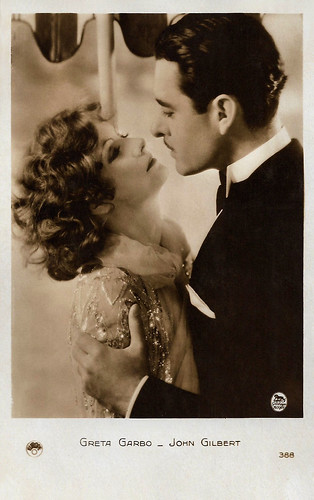
French postcard by Europe, no. 388, distributed in Italy by Casa Editrice Ballerini & Fratini, Firenze. Photo: James Manatt / Metro-Goldwyn-Mayer. Greta Garbo and John Gilbert in A Woman of Affairs (Clarence Brown, 1928).
"Garbo had something behind the eyes that you couldn't see until you photographed her in close-up. You could see thought. If she had to look at one person with jealousy, and another with love, she didn't have to change her expression. You could see it in her eyes as she looked from one to the other. And nobody else could do that on the screen." (director Clarence Brown in a 1968 interview).

French postcard by Europe, no. 330. Photo: Metro-Goldwyn-Mayer. Greta Garbo in The Divine Woman (Victor Sjöström, 1928).
Minor Star
Greta Gustafson garnered a couple of good trade reviews. It made her confident enough to seek out and win a scholarship to Dramaten, the prestigious Royal Dramatic Theatre in Stockholm. While studying acting there, she appeared in the historical film En lyckoriddare/A Happy Knight (John W. Brunius, 1921) which features Gösta Ekman as the dashing rogue who steals the heart of the ethereal Mary Johnson. Greta played a maid.
Then she met Mauritz Stiller, one of Sweden's foremost film directors in the early 1920s. Stiller trained the 18 years old in cinema acting techniques and gave her the stage name Greta Garbo. He cast her in a major role opposite Lars Hanson in Gösta Berlings Saga/The Legend of Gosta Berling (Mauritz Stiller, 1924). The epic drama was based on a novel by Nobel Prize winner Selma Lagerlöf.
Gösta Berlings Saga was internationally successful and made Greta a minor star. On the strength of this role, she was cast in the German prostitution and depression melodrama Die Freudlose Gasse/The Joyless Street (G.W. Pabst, 1925), in which she co-starred with the Danish screen legend Asta Nielsen.
And then Hollywood called. Louis B. Mayer invited Stiller to work for MGM when Gösta Berlings Saga caught his attention. On viewing the film, Mayer admired Stiller's direction but was not impressed with Garbo's acting and screen presence.
Mauritz Stiller insisted on bringing his protégé to Hollywood, thus, Mayer offered her a contract as well. Later, Garbo’s fame in Hollywood grew while Stiller struggled in the studio system. In 1928 Stiller was abruptly fired from directing Garbo's second MGM film, The Temptress (1926), after repeated arguments with studio execs. After a few more films at another studio, Stiller returned to Sweden, where he died soon after. He was only 45 and reportedly, Garbo was devastated.
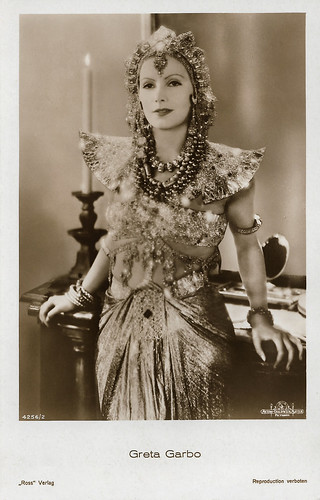
German postcard by Ross Verlag, no. 4256/2, 1929-1930. Photo: Metro-Goldwyn-Mayer. Publicity still for Wild Orchids (Sidney Franklin, 1929).
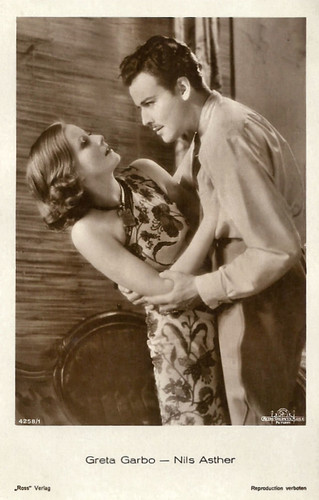
German postcard by Ross Verlag, no. 4258/1, 1929-1930. Photo: Metro-Goldwyn-Mayer. Publicity still for Wild Orchids (Sidney Franklin, 1929) with Nils Asther.
During the production of Wild Orchids, Mauritz Stiller died in Sweden. Devastated by his death, Garbo travelled to Stockholm incognito to mourn his death. Her secretive travel plans were quickly foiled when she was recognised on the voyage.
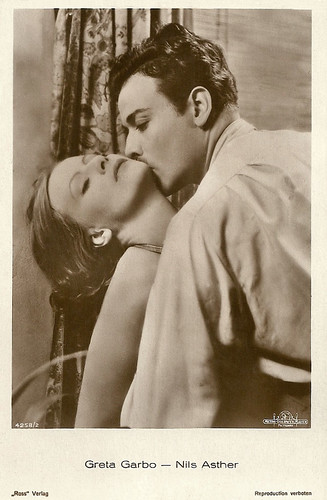
German postcard by Ross Verlag, no. 4258/2, 1929-1930. Photo: Metro-Goldwyn-Mayer. Greta Garbo and Nils Asther in the late silent film Wild Orchids (Sidney Franklin, 1929).
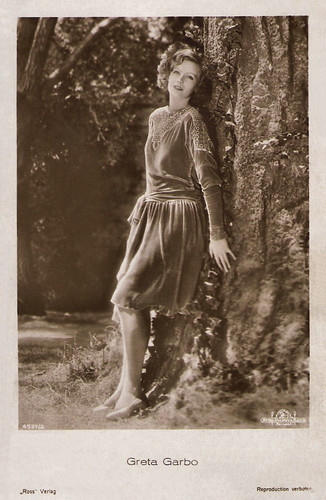
German postcard by Ross Verlag, no. 4527/2, 1929-1930. Photo: Clarence Bull / Metro-Goldwyn-Mayer.
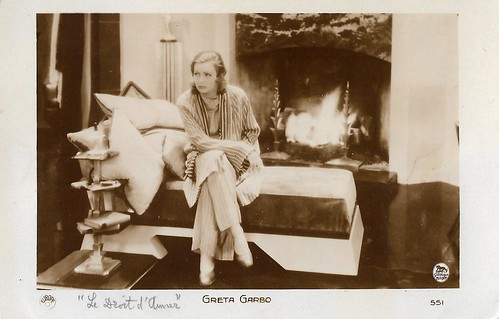
French postcard by Europe, no. 551. Photo: Metro-Goldwyn-Mayer. Greta Garbo in The Single Standard (John S. Robertson, 1929), released in France as Le Droit d'aimer.
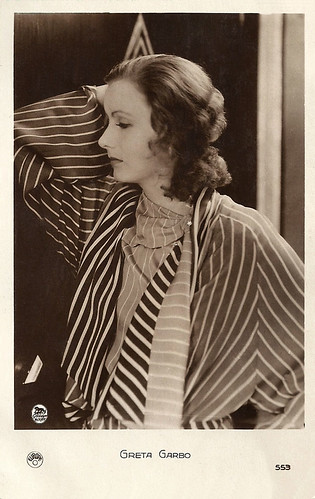
French postcard by Europe, no. 553. Photo: Ruth Harriet Louise / Metro-Goldwyn-Mayer. Publicity still for The Single Standard (John S. Robertson, 1929). Gown by Adrian.

German postcard by Ross Verlag, no. 5516/1, 1930-1931. Photo: Metro-Goldwyn-Mayer (MGM).
Lew Ayres co-starred with Garbo in her last silent film The Kiss (1929), directed by Belgium-born director Jacques Feyder and scripted by German screenwriter Hanns Kräly. After this successful film, Feyder directed Garbo again in the German version of Anna Christie (1930) and then returned to France. There he produced his greatest achievements: Le Grand Jeu (1934), Pension Mimosas (1935) and La Kermesse Héroique/Carnival in Flanders (1935).
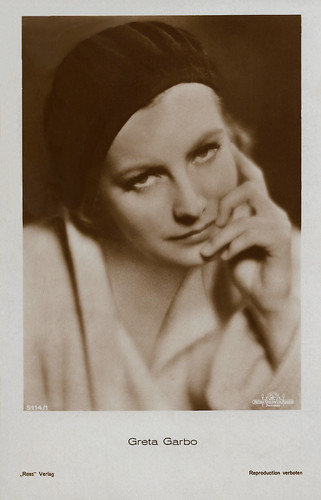
German postcard by Ross Verlag, no. 5114/1, 1930-1931. Photo: Clarence Sinclair Bull / MGM. Publicity still for The Kiss (Jacques Feyder, 1929).
Sources: Garbo Forever and IMDb.
No comments:
Post a Comment